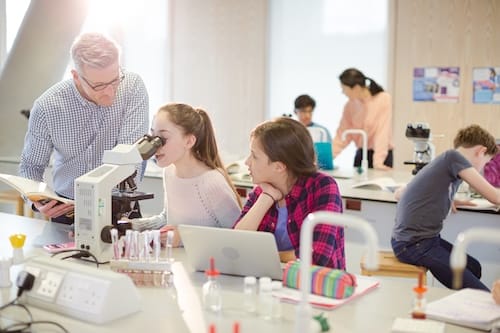Key points:
Today’s workforce requires adaptable, skilled individuals with the confidence to creatively apply background knowledge to complex, real-world opportunities. However, many students receive inconsistent support needed to understand how the background knowledge they acquire during classroom instruction connects to the world beyond the classroom, including a future career.
According to the Post Graduation Readiness Report, 83 percent of students cannot link the skills they learn in the classroom to future employment. Even more telling, recent research shows that while 88 percent of district leaders, teachers, parents, and students rate life skills as very important, only 57 percent of students believe their schools adequately teach the life skills needed for future success.
With more than 170 million new jobs projected by 2030, connecting classroom learning to real-world careers has never been more critical. For students to thrive in today’s competitive job market, K-12 education must serve as a bridge connecting classroom learning with real-world applications.
Two ways school systems can make that important connection is through robust Career and technical education and engaging career exploration experiences.
Practical learning as a gateway to careers
Career and technical education (CTE) blends classroom instruction with practical training, projects, and certifications. CTE helps students develop specialized skills and gain the confidence needed to succeed in their chosen fields.
Over the past 160 years, CTE has evolved to meet the economic and workforce demands of the time. Today, it has become an integral part of our education system, helping prepare students for a competitive workforce and setting them on a path to becoming lifelong learners.
Many states now offer CTE programs for students. For example, in Maryland and Virginia, students can participate in initiatives like dual enrollment, apprenticeships, and internships. These programs offer students access to industry concepts while helping them master the competencies crucial for success in the workplace. Mentorship programs also play an invaluable role in supporting and inspiring students. Mentors not only inspire students but also model critical soft skills in real time, like teamwork, critical thinking, and adaptability.
Increasing career visibility to spark curiosity
Generally, students cannot aspire to careers they don’t see or know exist. Bringing professionals into the classroom, either in person or virtually, allows educators to foster curiosity and broaden students’ horizons by kickstarting an interest in and awareness of unique careers.
Collaboration between partners and industry leaders creates resources that showcase real-world career experiences. The STEM Careers Coalition offers an abundance of free, on-demand career profiles (plus accompanying classroom standards-aligned activities) while Career Connect enables educators to bring professionals from industries directly into classrooms virtually.
Research shows that 90 percent of educators believe that curiosity is essential to student learning. Today’s students nurture that curiosity by exploring how careers in agriculture, sustainability, conservation, biotechnology, and more, all connect as part of a larger, evolving workforce and classroom lessons. These programs are as unique as the students who will use them and the companies featured within them. Examples include Cooperative Minds, which explores modern agricultural careers; Sustainable Futures, featuring Trane Technologies’ work in energy-efficient indoor environments; Conservation Station with Itron, which highlights roles in smarter city development; and Futurelab+ with Genentech, which opens the door to innovation in the rapidly growing field of biotechnology.
These resources not only demonstrate the countless number of career paths available, but also help students conceptualize how their studies directly link to these future roles by seeing that knowledge in action.
The role of educators and partnerships
Educators play an essential role in supporting both CTE and career exploration initiatives by elevating the link between academics and careers. Embedding career-relevant themes into the curriculum–such as STEM projects focusing on real-world challenges or adding communication and critical thinking as a part of an assignment–helps students see the real-world value of what they are learning.
Schools can expand CTE programs by aligning with regional job markets to offer students valuable skills and certifications. This leads to stronger partnerships with local businesses that create meaningful internship, mentorship, and apprenticeship opportunities tailored to student interests. Programs that incorporate career exploration help students build essential skills, like communication and problem solving, while exploring new career opportunities.
Additionally, districts can support educator development by providing training to help equip teachers with the knowledge, tools, and techniques needed to effectively deliver career-focused instruction. This fosters stronger community engagement in classrooms, creating a framework for collaboration with parents, local leaders, and alumni to enhance student access to high-quality career-based programs.
By making education more relevant to students’ personal and progressional growth, educators can help them develop the skills and confidence they need to thrive beyond the classroom.
The vision for the future of education
With rapid technological advancements, an ever-changing global ecosystem, a growing emphasis on job-based skills, and a national need for a highly skilled workforce, students are rightfully thinking about their futures. It’s up to today’s educators and leaders to ensure the current education systems meet their needs and find ways to blend academic learning with career preparation.
Stephen Wakefield 2025-08-04 12:20:47
Source link

